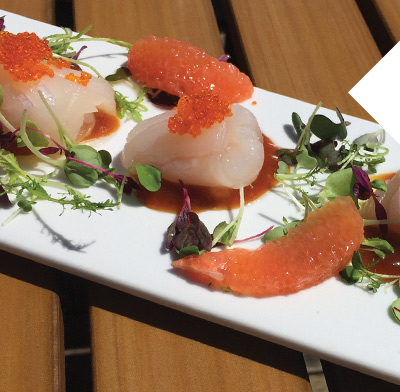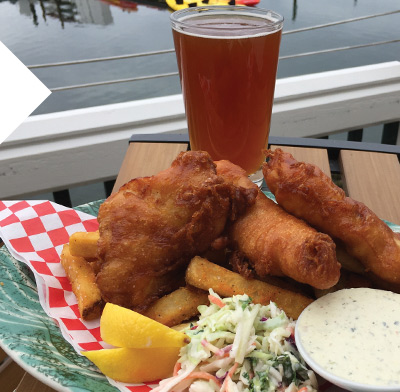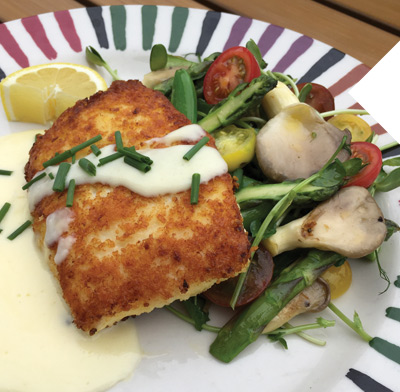Thanks to the productive waters of Alaska and Canada, fresh Pacific halibut is available in markets everywhere through most of the spring, all summer, and late into the fall. Unfortunately for us, the fish quotas during these months keep the price a little high. But who doesn’t love halibut?
Halibut are the largest of the flatfish family, which includes flounder and sole, growing to more than 500 lbs. When halibut are born, they look like any other newborn fish. At around six months of age, one eye begins to move from one side of their face to join the other more dominant eye. Soon after, the dominant side begins to change to a dark brown, the other side turns white. This gives the halibut the advantage of being able to blend in to the bottom of the sea to avoid predators, and when swimming above the ocean floor, their white bellies make them invisible to the prey below. Prior to the 1970s, halibut was mainly a derby fish, but in the late ‘70s halibut started appearing on menus in fine dining restaurants everywhere. Today it is as popular as salmon.
When buying halibut or any fish from the market, it should be bright in color and have a pleasant aroma like a fresh ocean breeze. Purchase halibut in fillet form and avoid pre-cut portions. Choose a thick fillet and cut the portions at home. Remember that halibut is a lean fish with less than 10 percent body fat, so I prefer to cut halibut in thick blocks or steak cuts. Thicker cuts prevent the fish from being overcooked and becoming dry. Halibut is best cooked to an internal temperature of 120℉ ; retaining the natural juices inside the fish creates an amazing experience that will make any cook a four-star chef. A probe thermometer that reads from 0℉ to 220℉ is an amazing tool to have in your collection and will take the guessing out of knowing when your fish is cooked.
I have chosen a few of my favorite recipes that highlight the subtle flavors of this mild white fish. After a day of fishing or coming home from the market, I like to offer a taste of the natural fish itself as a starter. Halibut is excellent raw and can be overpowered by stronger, more dominant flavors, so be sure to keep it simple and light. Enjoy!

|
Halibut Crudo with Grapefruit PonzupHalibut is a very lean fish with less than 10% fat content, and its mild flavor will complement an abundant range of cooking preparations. When serving the fresh catch of the day to friends, I like to offer a small, raw appetizer or amuse-bouche of the same fish I am serving as the main course. Halibut is the perfect choice to offer guests who are a little unsure about eating raw fish. This recipe has so many flavors competing for attention that the halibut provides a subtle background flavor.
For the halibut crudo, sprinkle the halibut with sea salt and refrigerate for 30 minutes to marinate. To prepare grapefruit segments, cut stem and flower ends off the grapefruit. Place grapefruit on cutting board sliced end down. Using a paring knife, remove the peel and white pulp from grapefruit to expose the fruit. Hold grapefruit in hand and gently slice alongside the membranes of each segment, then remove each wedge slice from fruit. When all the segments are removed, squeeze the remains of the grapefruit into a bowl and reserve for ponzu sauce. Slice halibut into 8 thin pieces about 2” long by ½” thick. On a chilled ceramic plate, place 8 little puddles of ponzu sauce spread across the plate. Roll each halibut slice into a tight roll, then place each roll on top of the ponzu puddles. Add two drops of white truffle oil and ¼ teaspoon of tobiko caviar on top of each halibut roll. Garnish the plate with grapefruit segments and micro greens. Serve immediately. Grapefruit Ponzu
In a heavy-bottomed saucepan over medium heat, add lime juice, soy sauce, grapefruit juice, rice wine vinegar, fresh ginger, and sugar. Bring to a slow boil. When liquid is reduced by half, remove from heat, pour into a glass bowl, and refrigerate until ready to serve. |
Beer Battered HalibutMy first memory of beer battered halibut was when I was about six years old. My dad had just returned from a fishing trip in Seward, Alaska, and invited a few families over for a fish fry. My dad’s fishing buddies stood around a large pot over an oversized military burner, laughing and sharing stories about fishing and jokes that they had played on each other earlier that day when, suddenly, my dad shoved a warm golden chunk of fried fish in my hand. As I bit through the crispy, salty crust and tasted the moist, flavorful halibut, I was hooked. I spent many years ordering fish and chips at restaurants trying to repeat that experience, but my memory of that first fried halibut has never been repeated.
Inspect the fillet of halibut and trim any gray fat or bone fragments from fillet before serving. Some people don’t mind the gray fat, but everyone will prefer if you remove it. The fat has an oily taste that can be offsetting, and nothing is more impressive than biting through the crispy brown batter and seeing delicate white fish. Cut into 1-oz. blocks or 1½” by 1½”. I prefer cutting halibut into blocks because it is so lean and can overcook easily when cut thin. Season the fish blocks with salt and pepper, then place in the refrigerator, wrapped in food film. In a Dutch oven or equally sized pan, add oil to a depth of 4”, then place pan over medium high heat until oil reaches 350o F on a digital thermometer. If you do not have a thermometer, drop a teaspoon of beer batter in the hot oil and if it floats on the top and slowly turns brown, the temperature of the oil is close. Using a medium-sized bowl, add flour, corn starch, baking powder, sugar, kosher salt, and seasoning salt. Stir ingredients until combined well. Add cold beer and stir with a wire whip until a thick batter is formed. Note: The correct consistency of the batter is key to making a great piece of breaded fish. If the batter is too thick, the fried fish will resemble a corn dog without the stick, and if the batter is too thin, the batter will not coat the fish when frying. The correct batter consistency will be thinner than pancake batter and when whisking, it will leave raised rings of batter. For guaranteed results, test a small piece of fish first by dipping it in the batter and dropping it in the fryer. For best results get everything that you are serving with the fish ready to be plated before starting to fry. The last thing you should be putting on the plate is a hot, crispy, golden piece of fish. Once the batter is perfected and the oil is at the perfect temperature, place a wire rack over another pan to drain the fish after it is cooked (if you do not have a wire rack, place a couple layers of bunched-up paper towels on a large plate to absorb the oil). Now that you are ready to fry the fish, add the seasoned fish to the beer batter and gently coat the fish with the batter. Using tongs, pull each piece out of the batter and dip into the hot oil and hold for 3 seconds, allowing the batter to cook slightly before dropping in the oil. This will prevent the battered fish from sticking to the bottom of the pan. Add the remaining battered fish to the hot oil being careful not to overcrowd the pan. Turn the battered fish so that all sides are cooked evenly. Once crispy and golden brown, remove with tongs and place on rack to remove excess oil. Serve immediately with fresh lemon and tartar sauce if you prefer. |

|

|
Asiago Crusted HalibutCheese-crusted fish with a butter sauce, what could be better!? When I describe this dish to the servers in the restaurant, I remind them of the grilled cheese sandwich that Mom made for them; “Remember the cheese that escaped out of the sandwich and dripped onto the hot buttered pan, bubbling and burning against the crust of the bread?” Some moms would have never let that happen, but mine did, and I grew up loving that bitter, little, crunchy cheese bit. The nutty flavor of the Parmesan combined with the richness of the Asiago is seared onto this delicate fish and creates an amazing contrast of flavors. Try this recipe with oyster and scallops as well. Serves Six
I like to use the block cut portion of lean fish to retain the moisture of the seafood while cooking. Depending on the size of halibut, a 2” thick steak cut is recommended. After the fish is portioned, season fillets (the small fish portion vs. the larger fillet) with salt and pepper. Combine the egg and milk in a small bowl and mix well, then refrigerate until next step. For Asiago breading, grate the Asiago and Parmesan into a fine powder. Using a food processor, pulse the panko breadcrumbs into a fine powder. Combine cheese and pureed breadcrumbs. Gently dip the fillets in egg and milk mixture and then press into the cheese and panko mixture. Turn the fillet over and repeat. After all fillets are crusted with the Asiago cheese mixture, place on a plate in a single layer, and refrigerate until ready to sauté. To clarify butter, place 1 stick of butter in a heatproof glass measuring cup and microwave on high for 40 seconds. After the butter is melted, let stand for 5 minutes in a warm place in the kitchen. The butter is now separated into three layers; the top layer is salt and some solids, the middle layer is the oil from the butter that we are after, and the bottom layer is the water. Using a spoon, skim off the top layer of salt and discard. Poor off the clear yellow oil into a bowl being careful not to get any of the water from the bottom layer into the oil. Discard the milky water from the measuring cup. The clear yellow oil is clarified butter that will be used to cook the fish. Place a cast iron pan or griddle over medium high heat. Place a small amount of clarified butter on the hot pan, then spread over entire surface. When the surface of the cast iron is hot, place the crusted fish on the hot griddle for 2 to 3 minutes or until the fish is golden brown. Turn the fish over and continue cooking until the internal temperature of the fish is 120o F or firm to the touch. Place the cooked Asiago-crusted fish on a warm dinner plate, then ladle 1 oz. of beurre blanc over fish and garnish with chopped chives. Beurre Blanc Sauce (makes 6 oz.)
In a heavy-bottomed saucepan over medium-high heat, add the shallots, white wine vinegar, and white wine. Reduce to a light syrup, reducing by approximately 90%. Reduce heat to medium and add heavy cream. Reduce to ½ or ¼ cup. Note: Do not scorch sauce. Remove from heat if necessary. Reduce heat to low and whip in the butter. We are not melting the butter but softening it to form a soft and silky sauce. Season with salt and pepper and hold warm until ready to serve. |